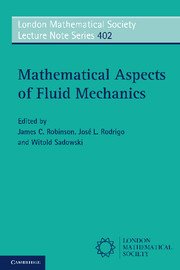Book contents
- Frontmatter
- Contents
- Preface
- List of Contributors
- 1 Towards fluid equations by approximate deconvolution models
- 2 On flows of fluids described by an implicit constitutive equation characterized by a maximal monotone graph
- 3 A continuous model for turbulent energy cascade
- 4 Remarks on complex fluid models
- 5 A naive parametrization for the vortex-sheet problem
- 6 Sharp and almost-sharp fronts for the SQG equation
- 7 Feedback stabilization for the Navier–Stokes equations: theory and calculations
- 8 Interacting vortex pairs in inviscid and viscous planar flows
- 9 Stretching and folding diagnostics in solutions three-dimensional Euler and Navier–Stokes equations
- 10 Exploring symmetry plane conditions in numerical Euler solutions
- 11 On the decay of solutions of the Navier–Stokes system with potential forces
- 12 Leray–Hopf solutions to Navier–Stokes equations with weakly converging initial data
- References
10 - Exploring symmetry plane conditions in numerical Euler solutions
Published online by Cambridge University Press: 05 November 2012
- Frontmatter
- Contents
- Preface
- List of Contributors
- 1 Towards fluid equations by approximate deconvolution models
- 2 On flows of fluids described by an implicit constitutive equation characterized by a maximal monotone graph
- 3 A continuous model for turbulent energy cascade
- 4 Remarks on complex fluid models
- 5 A naive parametrization for the vortex-sheet problem
- 6 Sharp and almost-sharp fronts for the SQG equation
- 7 Feedback stabilization for the Navier–Stokes equations: theory and calculations
- 8 Interacting vortex pairs in inviscid and viscous planar flows
- 9 Stretching and folding diagnostics in solutions three-dimensional Euler and Navier–Stokes equations
- 10 Exploring symmetry plane conditions in numerical Euler solutions
- 11 On the decay of solutions of the Navier–Stokes system with potential forces
- 12 Leray–Hopf solutions to Navier–Stokes equations with weakly converging initial data
- References
Summary
Abstract The motion of the position of the maximum of vorticity ∥ζ∥∞ and growth of enstrophy are explored numerically using a recent calculation at moderately high resolution. We provide an exact analytic formula for the motion of ∥ζ∥∞ in the symmetry plane and use it to validate the numerical data. This motion drifts with respect to the local Lagrangian frame of reference due to the local gradient of vortex stretching, and can thus be associated with depletion of the circulation in the symmetry plane from the vicinity of ∥ζ∥∞. Despite this depletion, the numerical data is consistent with singular growth of the 3D enstrophy and symmetry-plane enstrophy that is bounded by inequalities analogous to the type known for the three-dimensional Navier-Stokes equations, using their respective enstrophies and with the viscosity being replaced by the circulation invariant.
Introduction
After the proof that the time integral of maximum vorticity controlled any possible singularities of the three-dimensional incompressible Euler equations (Beale, Kato, & Majda, 1984), it was realized that this was a quantity of low enough order to be accessible by numerical simulations, and the quest to determine numerically whether or not the Euler equations develop singularities ensued.
However, apparent singular growth in one quantity is insufficient for claiming consistency with singular growth as it is difficult to distinguish singular power-law growth from strong, but non-singular growth such as the exponential of an exponential. At a minimum, the growth in stretching near the position of maximum vorticity needs to be tracked independently and should grow in a manner consistent with the mathematical bounds, as first suggested by Pumir & Siggia (1990).
- Type
- Chapter
- Information
- Mathematical Aspects of Fluid Mechanics , pp. 221 - 234Publisher: Cambridge University PressPrint publication year: 2012
References
- 1
- Cited by

